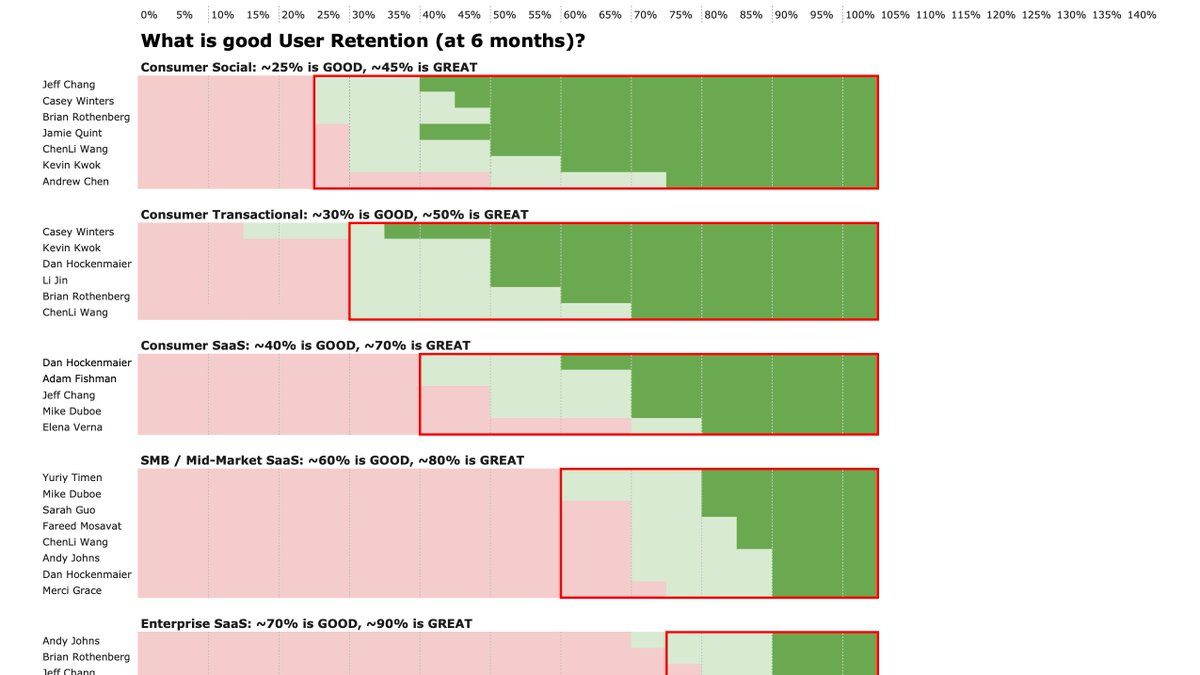A deep dive into what GOOD and GREAT retention look like, for all types of businesses, with concrete recommendations from 20 of the world& #39;s top growth experts.
Highlights in thread below
1/ While retention is widely considered to be most important metric to get right when building a business, it’s also one of the least understood. Why? Because unless you’re a growth expert or an experienced investor, you’re often forced to rely on guesses and anecdotes.
2/ To come up with a benchmark we could trust, @onecaseman and I reached out to the most experienced growth practitioners we knew and asked them two questions:
1. What do you consider GOOD and GREAT user retention?
2. What do you consider GOOD and GREAT net revenue retention?
1. What do you consider GOOD and GREAT user retention?
2. What do you consider GOOD and GREAT net revenue retention?
3/ Taking these insights and combining them with available public data, we’ve come up with a set of concrete recommendations for GOOD and GREAT retention across most types of businesses.
5/ User retention:
• Consumer Social: ~25% is GOOD, ~45% is GREAT
• Consumer Transactional: ~30% is GOOD, ~50% is GREAT
• Consumer SaaS: ~40% is GOOD, ~70% is GREAT
• SMB / Mid-Market SaaS: ~60% is GOOD, ~80% is GREAT
• Enterprise SaaS: ~70% is GOOD, ~90% is GREAT
• Consumer Social: ~25% is GOOD, ~45% is GREAT
• Consumer Transactional: ~30% is GOOD, ~50% is GREAT
• Consumer SaaS: ~40% is GOOD, ~70% is GREAT
• SMB / Mid-Market SaaS: ~60% is GOOD, ~80% is GREAT
• Enterprise SaaS: ~70% is GOOD, ~90% is GREAT
6/ Net Revenue Retention:
• Consumer SaaS: ~55% is GOOD, ~80% is GREAT
• Bottoms Up SaaS: ~100% is GOOD, ~120% is GREAT
• Land and Expand VSB SaaS: ~80% is GOOD, ~100% is GREAT
• Land and Expand SMB / Mid-Market SaaS: ~90% is GOOD, ~110% is GREAT
• Consumer SaaS: ~55% is GOOD, ~80% is GREAT
• Bottoms Up SaaS: ~100% is GOOD, ~120% is GREAT
• Land and Expand VSB SaaS: ~80% is GOOD, ~100% is GREAT
• Land and Expand SMB / Mid-Market SaaS: ~90% is GOOD, ~110% is GREAT
7/ As a bonus, @onecaseman also wrote an essential companion post delving into ways to increase retention, amongst other topics. Don& #39;t miss it. https://caseyaccidental.com/what-is-good-retention">https://caseyaccidental.com/what-is-g...
8/ Lastly, a HUGE thank you to these incredible contributors @fishmanaf @andrewchen @ibringtraffic @bbalfour @bmrothenberg @chenliw @danhockenmaier @ElenaVerna @far33d @jamiequint @JeffChang30 @kevinakwok @ljin18 @merci @mduboe @npilosof @nicksoman @saranormous @shaunmclowes
I love how passion-inducing retention turned out to be  https://abs.twimg.com/emoji/v2/... draggable="false" alt="🤯" title="Explodierender Kopf" aria-label="Emoji: Explodierender Kopf">
https://abs.twimg.com/emoji/v2/... draggable="false" alt="🤯" title="Explodierender Kopf" aria-label="Emoji: Explodierender Kopf">
I& #39;ve been following the conversation, and it seems like the key question founders/leaders face is what to feel/do if your retention is lower than these benchmarks (which most startups will experience).
I& #39;ve been following the conversation, and it seems like the key question founders/leaders face is what to feel/do if your retention is lower than these benchmarks (which most startups will experience).
To some, these retention benchmarks will seem high. This is because the bar to build a massively successful business is high. It’s why most startups fail.
However, retention doesn’t live in vacuum. There are cases where a lower retention rate is OK:
However, retention doesn’t live in vacuum. There are cases where a lower retention rate is OK:
1. You’re just starting out: Don’t despair if you don’t see this level of retention immediately. Use these benchmarks a guide to prioritize between retention vs. acquisition, and read Casey’s post for three ways to approach increasing retention. https://caseyaccidental.com/what-is-good-retention">https://caseyaccidental.com/what-is-g...
2. You have low CAC and marginal costs: Growth is a balancing act between CAC, retention, and unit economics. If you can acquire new users cheaply (e.g. SEO, WOM), you can afford to lose more users. This thread by Dan Hockenmaier explains it well. https://twitter.com/danhockenmaier/status/1270376412642373633">https://twitter.com/danhocken...
3. You’re not building a venture-scale business: These benchmarks are coming from people who helped build iconic, massively scalable, businesses. This level of retention is not required for product/market fit, or to build a sustainable business...
3. (continued) Though the upside will be limited, a flat retention curve that drives a scalable acquisition strategy is enough to keep your business alive. https://twitter.com/far33d/status/1270744119007051776">https://twitter.com/far33d/st...

 Read on Twitter
Read on Twitter


